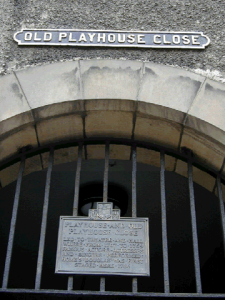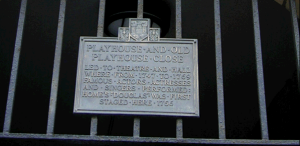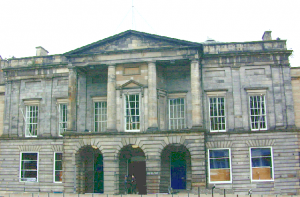Leisure in Edinburgh

- Old Playhouse Close
- [click on the picture to enlarge it]
At the start of the eighteenth century, daily life for Scottish people was grave and austere, and nothing could relieve the sinister monotony. The church, be it Episcopal or Presbyterian, had a very strong influence on churchgoers and controlled most of their acts. Attending service on Sundays was not a question of choice, but of obligation. All urgent tasks had to be abandoned, all frivolous activity suspended; religion was sovereign and took precedence over everything else. In towns, as well as in the country, this strict religious discipline was observed. In Edinburgh, Sunday was devoted to worship and churches were full of people, the traveller John Macky observed in his book A Journey through Scotland (London, 1723):
Certainly no Nation on Earth observes the Sabbath with that Strictness of Devotion and Resignation to the Will of God, They all pray in their Families before they go to Church, and between Sermons they fast; after Sermon every Body retires to his own home, and reads some Book of Devotion till Supper . . . after which they sing Psalms till they go to Bed (3).
Few distractions were offered to the inhabitants of Edinburgh and to their visitors. John Macky says that he attended concerts in the Scottish capital. Balls were also given in high society and some theatre plays were performed, but austerity seemed to have been adopted everywhere at this start of the century, and few Scots dared to take part in the joys of life without second thoughts.
A morbid existence was led in very many serious households in Scotland. There life assumed a sombre aspect, and the pleasures of the world were taken sadly. Dancing was a carnal excitement, cards a dangerous pastime, dicing was an impious game. The theatre was the devil’s playground, and dancing assemblies were the recruiting quarters for Satan’s ranks.
Henry Grey Graham, The Social Life of Scotland in the Eighteenth Century (London, 1899; rpt. London: Adam and Charles Black, 1969) 345
Second half of the 18th century

- Playhouse Close
- Detail of the plaque in Playhouse Close, with a reference to the performance of Douglas.
[click on the picture to enlarge it]
Edinburgh, considered for a long time as ’a mere mass without spirits’, in the words of the traveller Edward Topham in Letters from Edinburgh, Written in the Years 1774, 1775 (London, 1776, 100) had become at the end of the 18th century a cheerful town, teeming with distractions, attracting numerous visitors thanks to the variety and the quality of its shows and concerts.
The musical and theatrical season in Edinburgh started in January and finished in March, three months during which the town was literally taken over by foreigners and by the Scottish landowning aristocracy come to winter in the capital and to make the most of the festivities offered. At this time, the theatre was extremely popular with the public and was no longer laid under interdict by representatives of the Church of Scotland. Quite to the contrary, these latter took advantage of the annual meeting in the capital to attend theatre performances and to applaud the famous English actress Mrs Siddons (1755 - 1831). This was indeed a comical reversal of situation when one imagines that in 1756 the Rev. John Home was suspended from his functions by the rigid ’Kirk’ (Church of Scotland), because he had dared to write and have performed in Edinburgh his play Douglas, an innocent tragedy that was in no way immoral. Its success was immense, despite the censure both in Edinburgh and in London, where it was performed in 1757 at Covent Garden.
At the end of the eighteenth century, Edinburgh boasted two permanent theatres, the Royal Theatre (1768) and the Circus, built in 1788 to give equestrian shows and pantomimes, and then definitively transformed into a theatre in 1809.
The Assembly Rooms in George Street

- The Assembly Rooms in George Street
- [click on the picture to enlarge it]
In 1787, society life in Edinburgh was marked by an event that several travellers did not fail to comment upon; the opening of the sumptuous Assembly Rooms in George Street, described by the Rev. Stebbing Shaw in the account of his travels A Tour in 1787 from London to the Western Islands of Scotland (London, 1788):
Tho’ a very heavy building on the outside, and without external ornaments, yet, upon entering its various apartments (ball-room, tea-room, two card rooms) you are agreeably surprized with some of the completest rooms perhaps in Europe. In the ball-room, eleven very rich lustres light and ornament this room. (192)
At the end of the eighteenth century, Edinburgh in no way resembled the peaceful provincial town of the start of the century. Morals were more dissolute than before. The inhabitants no longer made it their duty to regularly attend church, to listen attentively to the Sunday sermons, and the churches were little by little deserted. While the men went assiduously to their clubs and were a bit too fond of the divine bottle, women of the best society were not averse to having a good time too. They organised evenings called ’oyster-cellars’, where they invited whoever they wanted and enjoyed oysters, brown ale or flambéed punch in gallant company, before throwing themselves into an unrestrained ’reel’ in the arms of their partners.
Edinburgh underwent in fact the same fate reserved for all the European capitals in full boom, but if the morals of its inhabitants had slackened as the years passed, it had not transformed for all that into a town of pleasures and debauchery. In the eyes of the Scots and of visitors, Edinburgh remained a unique and fascinating town, a symbol even of the new Scotland at the end of the eighteenth century, resolute and confident in its destiny.

